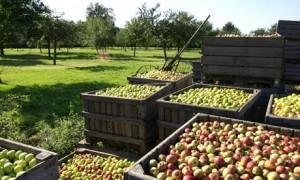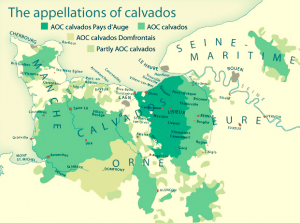
Calvados, Every Apple’s Aspiration
Calvados is the world famous, and rightfully so, apple based Brandy from the Normandy region of France. Despite the station that Calvados enjoys among spirits aficionados it’s still sadly unknown among most American consumers. As a point of reference only about 200,000 bottles of Calvados are sold in the U.S. as compared to the 40 million bottles of Cognac consumed. That’s a staggering gap of 200 to one.
When you wander the beautiful, rolling, pastoral hills of Normandy the first thing that you may notice is that orchards have taken the place of vines that dominate so many other regions. It has been this way for some time as the Romans took note of the plentiful apples and pears growing in Normandy. Of course, it’s all about the fruit.
Jumping ahead to the 15th century, cider consumption in France was on par with wine. This continued until the 17th century until new tax regulations and a prohibition on distilling cider in most all regions with the exception of Brittany, Maine, and Normandy.
The Calvados region in its first incarnation was created after the French Revolution in the beginning of the 19th century. As distilled cider caught on and production increased the simple “café-calva” (Calvados Brandy and coffee) became a working class staple.
While having centuries of history, Calvados was not officially recognized until 1942 earning the official AOC Calvados, two years before the Normandy invasion on D-Day in World War II.
(France’s appellation d’origine contrôlée (AOC), is the official designation that identifies products such as wine, spirits, cheese, and more to specific regions and protects the name and production standards.)
Calvados – How Do You Like Them Apples?

Calvados is All About the Apples
There are more than 6,000 varieties of apples grown in the world and 48 of these varieties are recommended for use in Calvados. (Recommended but not restricted as many more than 48 varieties are found here.) Apple varieties best suited for Cider and Brandy are categorized simply as: sweet, bittersweet, bitter, and acidic. Each producer carefully blends the whole apples, before crushing, in the desired proportions with most using a majority of the bittersweet varieties. As you would expect the harvest of these unique varieties occur at different dates as the typical harvest starts in mid-October and extends to December.
These Cider apples are not like the apples you are accustomed to from your local grocer. These are hard, quite tannic, and dry and will within seconds extract every bit of moisture in your mouth. This is a lesson that I learned the hard way but I will never forget it.
Of course, you cannot have Brandy until you first have Cider. It’s all about the cider. The Normandy region of France has long been known for orchards and cider. Why would you grow apples if you weren’t going to make cider? How many apple pies can one have in a year? Traditionally the Cider of Normandy is fermented spontaneously with the natural airborne yeasts adding another layer to the unique flavors that can only be achieved in this special place. Fermentation is slow lasting up to six weeks and resulting in a hard cider that is roughly 6% to 8% alcohol by volume.
Many of the 200-plus producers of Calvados (many of these are very small, selling fewer than 100 bottles a year) also produce Cider for consumption. As you would expect, it’s damn good and you would be well-awarded to seek out the Ciders from Normandy.
The Calvados Rules

A Map of the Calvados Appellations
We have pointed out that while Calvados has been around for centuries it was not until 1942 that it received official AOC recognition. Since then there have been several changes to the appellations of Calvados. There are three official appellations in Calvados and each bottle will prominently display their respective appellation.
Calvados Pays d’Auge is the original zone in the eastern portion of the larger Calvados AOC. In addition to being made with apples and pears (typically in small portions if used at all) from this delimited Pays d’Auge zone the Brandy must be double distilled in traditional pot stills. The Brandy must be aged for a minimum of two years.
Appellation (AOC) Calvados is the largest, all-encompassing appellation. The Calvados from AOC Calvados is made with both apples and pears in varying amounts and can be single, column-distilled or double distilled like Calvados Pays d’Auge. This large zone encompasses many smaller departments that were once singularly identified but they were grouped together in the 1980s.
Appellation (AOC) Calvados Domfrontais is the zone that surrounds the town of the same name in the southwest of the Calvados appellation. In simple terms, this is the pear appellation as it is required that the Calvados of this AOC utilize a minimum of 30% pear (often much more) in their blend. Distillation takes place in a single column still and the Brandy must be aged a minimum of three years in cask.
Aging & Bottling Calvados
Much of the Calvados that is seen in the marketplace is aged for a period of three to 10 years. Of course older examples are sold and when they are found they are often quite expensive and most often an unforgettable treat. Vintage Calvados is available, albeit in small quantities, with the boutique producer Christian Drouin being the largest, single holder of vintage Calvados.
Many Calvados are graded by age, as is the custom in Cognac and Armagnac. If you are familiar with the Cognac grade nomenclature the Calvados grades will be very familiar.
- “Fine” – must be at least two years old.
- “Vieux” or “Réserve” – must be at least three years old.
- “Vieille Réserve” or “VSOP” – must be at least four years old.
- “Extra”, “XO”, “Napoléon”, “Hors d’Age”, or “Age Inconnu” – must be at least six years old (most are much older).
Enjoying Calvados
Calvados is most often consumed as a digestif, post-dinner as Cognac another Brandies. However, young Calvados is a terrific aperitif especially when mixed with soda or ginger ale over ice as in the custom in Normandy.
In the years following the Second World War the tradition of enjoying café-calva (Calvados Brandy and coffee) was well-entrenched throughout France. For this reason it was difficult for many restaurateurs and spirits connoisseurs to see Calvados as a serious Brandy on par with Cognac. It took the tireless efforts of a handful of the region’s top, quality-minded producers to instruct influencers on the unique attributes of well-aged and vintage Calvados. It wasn’t until the 1980s that most Paris restaurants served older Calvados alongside Cognac and other revered digestifs.
